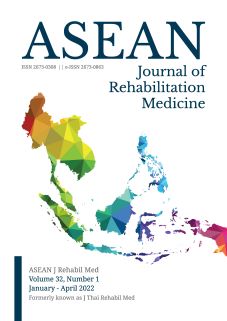Patient Compliance and Factors Related to Usage of Plastic Ankle-Foot Orthoses by Chronic Stroke Patients
Keywords:
foot orthosis, patient compliance, stroke rehabilitation, ambulationAbstract
Objectives: To investigate chronic stroke patient compliance with usage of plastic ankle-foot orthosis (AFO) and to identify factors significantly associated with compliance with AFO use.
Study design: Cross-sectional study.
Setting: Department of Rehabilitation Medicine, Siriraj Hospital and Sirindhorn National Rehabilitation Center.
Subjects: Chronic stroke patients who had received a plastic AFO at least one year ago, had no cognitive impairment, no aphasia, and who had visited a physiatrist for follow-up.
Methods: Patients’ demographic and clinical data were collected. Modified Barthel Index (mBI) and Functional Ambulation Category (FAC) were used for assessment. Patients were asked to complete a specially designed AFO use questionnaire. Patient compliance was defined as AFO use for ambulation for more than 3 hours per day at least 5 days per week over a period of not less than a year. Patients who did not meet those provisions were classified as non-compliant. Patient compliance/non-compliance with AFO usage was analyzed using descriptive statistics. Factors associated with compliance were analyzed using forward stepwise logistic regression.
Results: A total of 93 patients, 63 men and 30 women, with a mean age of 60 years were included in the study. Of those patients, 38.7% had discontinued the use of AFO, 61.3% reported continuous use of AFO, but only 23.7% were categorized as compliant with AFO usage. FAC level 4 or 5, independent ambulator on level surfaces only and independent ambulator, respectively, was the only factor statistically significantly related to patient compliance (odds ratio: 15.2, 95% confidence interval: 1.9-120.6).
Conclusions: Almost two-thirds of chronic stroke patients reported continuous usage of AFOs for at least a year, but only one-fourth could be categorized as compliant with AFO usage. Independent ambulation, including ambulation on level surfaces only, was the only factor independently associated with compliance with AFO use.
Keywords: foot orthosis, patient compliance, stroke rehabilitation, ambulation
References
Leung J, Moseley AM. Impact of ankle-foot orthoses on gait and leg muscle activity in adults with hemiplegia: systematic literature review. Physiotherapy. 2003;89:39-55.
Dogan A, Mengulluoglu M, Ozgirgin N. Evaluation of the effect of ankle-foot orthosis use on balance and mobility in hemiparetic stroke patients. Disabil Rehabil 2010;33:1433-9.
de Wit DC, Buurke JH, Nijlant JM, Ijzerman MJ, Hermens HJ. The effect of an ankle foot orthosis on walking ability in chronic stroke patients: a randomized controlled trial. Clin Rehabil. 2004;18:550-7.
Do KH, Song JC, Kim JH, Jung GS, Seo SW, Kim YK, et al. Effect of a hybrid ankle foot orthosis made of polypropylene and fabric in chronic hemiparetic stroke patients. Am J Phys Med Rehabil. 2014;93:130-7.
Hyun CW, Kim BR, Han EY, Kim SM. Use of an ankle-foot orthosis improves aerobic capacity in subacute hemiparetic stroke patients. PM R. 2015;7:264-9.
Mahoney F, Barthel D. Functional evaluation: the Barthel index. Md State Med J. 1965;14:61-5.
Mehrholz J, Wagner K, Rutte K, Meiner D, Pohl M. Predictive validity and responsiveness of the functional ambulation category in hemiparetic patients after stroke. Arch Phys Med Rehabil. 2007; 88:1314-9.
SPSS Inc. PASW statistics for windows, version 18.0. Chicago: SPSS; 2009
Tyson SF, Kent RM. Effects of an ankle-foot orthosis on balance and walking after stroke: a systematic review and pooled meta-analysis. Arch Phys Med Rehabil. 2013;94:1377-85.
Tyson SF, Sadeghi-Demneh E, Nester CJ. A systematic review and meta-analysis of the effect of an ankle-foot orthosis on gait biomechanics after stroke. Clin Rehabil. 2013;27:878-91.
Kesikburun S, Yavuz F, Güzelküçük Ü, Yaşar E, Balaban B. Effect of ankle foot orthosis on gait parameters and functional ambulation in patients with stroke. Turk J Phys Med Rehabil. 2017;63:143-8.
Nakipoğlu Yüzer GF, Koyuncu E, Çam P, Özgirgin N. The regularity of orthosis uses and the reasons for disuse in stroke patients. Int J Rehabil Res. 2018;41:270-5.
Hung JW, Chen PC, Yu MY, Hsieh YW. Long-term effect of an anterior ankle-foot orthosis on functional walking ability of chronic stroke patients. Am J Phys Med Rehabil. 2010;90:8-16.
Kluding PM, Dunning K, O’Dell MW, Wu SS, Ginosian J, Feld J, et al. Foot drop stimulation versus ankle foot orthosis after stroke 30-week outcomes. Stroke. 2013;44:1660-9.
Lehmann JF. Biomechanics of ankle-foot orthoses: prescription and design. Arch Phys Med Rehabil. 1979;60:200-7.
Rao N, Aruin AS. Role of ankle foot orthoses in functional stability of individuals with stroke. Disabil Rehabil Assist Technol. 2016;11: 595-8.
Cakar E, Durmus O, Tekin L, Dincer U, Kiralp M. The ankle-foot orthosis improves balance and reduces fall risk of chronic spastic hemiparetic patients. Eur J Phys Med Rehabil. 2010;46:363-8.
Nikamp CDM, Hobbelink MSH, van der Palen J, Hermens HJ, Rietman JS, Buurke JH. The effect of ankle-foot orthoses on fall/near fall incidence in patients with (sub-)acute stroke: A randomized controlled trial. PLoS One. 2019;14:e0213538. doi: 10.1371/journal.pone.0213538.
Pongpipatpaiboon K, Mukaino M, Matsuda F, Ohtsuka K, Tanikawa H, Yamada J, et al. The impact of ankle-foot orthoses on toe clearance strategy in hemiparetic gait: a cross-sectional study. J Neuroeng Rehabil. 2018;15:41. doi: 10.1186/s12984-018-0382-y.
Downloads
Published
How to Cite
Issue
Section
License
Copyright (c) 2021 ASEAN Journal of Rehabilitation Medicine

This work is licensed under a Creative Commons Attribution-NonCommercial-NoDerivatives 4.0 International License.






